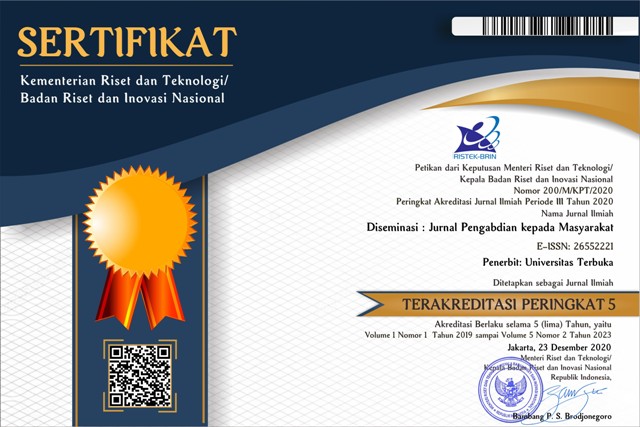UTILIZING PLASTIC BOTTLE WASTE WITH THE RE-USE METHOD
DOI:
https://doi.org/10.33830/diseminasiabdimas.v1i1.517Keywords:
re-use, creativity, side incomeAbstract
This public service program aims to improve the creativity of the community through the re-use of household waste. Not only exciting, this activity may also generate extra income for the community members. The method consists of understanding the issues of environmental health, identifying and determining inorganic waste, and improving creativity through workshops on utilizing inorganic waste to generate side income. The object of this program is the housewives at Dusun Mrisen, Sardonoharjo, Ngaklik, Sleman, Yogyakarta. The activity methods used in this program are lectures, demonstration, and practicum. This public service program is expected to contribute in the improvement of the community’s welfare
References
Chaesfa, Y. & Pandjaitan, N.E. (2013 ) Persepsi perempuan terhadap lingkungan hidup dan partisipasinya dalam pengelolaan sampah rumahtangga (kasus sebuah kampung di desa babakan, kecamatan dramaga, kabupaten bogor, provinsi jawa barat). Sodality : Jurnal Sosiologi Pedesaan ISSN : 2302 -7517, Vol. 01, No. 02. Agustus 2013, hlm: 165-181Marliani, N. (2014) . Pemanfaatan limbah rumah tangga (sampah anorganik) sebagai bentuk implementasi dari pendidikan lingkungan hidup. Jurnal Formatif 4(2): 124-132, 2014 ISSN: 2088-351X Sidarto, (2010). Analisis usaha proses pengeololaan sampah rumah tangga dengan pendekatan cost and benefit rasio guna menunjang kebersihan lingkungan. Jurnal Teknologi, Volume 3, Nomor 2, Desember2010 161-168_____________. Kamus Besar Bahasa Indonesia, versi online di, https://www.kbbi.web.iddiakses tanggal 25 Maret 2018.
Downloads
Published
Issue
Section
License
Copyright and Licensing

Diseminasi : Jurnal Pengabdian kepada Masyarakat is licensed under a Creative Commons Attribution-NonCommercial-NoDerivativeWorks 4.0 International License. Allows users to copy and distribute the Article, provided this is not done for commercial purposes and further does not permit distribution of the Article if it is changed or edited in any way, and provided the user gives appropriate credit (with a link to the formal publication through the relevant DOI), provides a link to the license, and that the licensor is not represented as endorsing the use made of the work.















